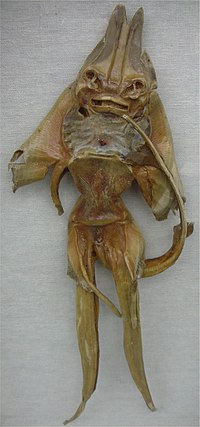Sea Bishop

The sea bishop or sea bishop is a mythical creature that was mentioned by some naturalists in the 16th and 17th centuries and believed to actually exist. He is a special genus of Aquarius , a male counterpart to the mermaid .
description
Descriptions and illustrations can be found, for example, by Pierre Belon , Conrad Gessner , Guillaume Rondelet and Ulisse Aldrovandi . The bishop-fish is a fish , dressed with dalmatic and Mitra described and occasionally with crosier displayed. The not very large creature should normally have a peaceful character, but should also be able to unleash storms when irritated. In Johann Zahn's book Specula physico - mathematico - historica notabilium ac mirabilium sciendorum (published in Nuremberg in 1696 ) a specimen is depicted that is said to have been caught alive in the Baltic Sea in 1531 . After refusing to eat, it died three days later. This event is also mentioned in Johannes Praetorius ´ «Description of the World».
However, some authors - for example Rondelet - expressed doubts about the reliability of the published images very early on and considered them to be overdrawn at that time, without, however, completely rejecting the existence of the Seebischof.
The Asian variant of the Sea Bishop is the Meerbonze or Umibozu of Japanese mythology.
Occurrence
Encounters with the sea bishop have been handed down from the Baltic Sea, the English Channel , the Red Sea and the Adriatic Sea . The descriptions are probably based on sightings of angel sharks or rays .
As proof of the existence of the Sea Bishop , seafarers presented so-called Jenny Hanivers , which they had acquired in the ports. They were dried violin rays , whose bodies were cut and draped with the belly side up in such a way that a spread out chasuble was created. The nostrils on the underside of the body were the eyes. The mouth of the fish, prepared accordingly, has a lot like a human mouth. The paired Klasper can be interpreted as legs with some imagination.
In 1837 Heinrich Heine wrote slightly ironically about the Seebischof in "Elementary Spirit":
"I am convinced that you all do not know that there are sea bishops? I even doubt whether the Gazette de France knows. And yet it would be important for some people to know that Christianity has its followers even in the ocean, and certainly in great numbers. Perhaps the majority of sea creatures are Christians, at least as good Christians as the majority of the French. I would like to keep this secret, so as not to please the Catholic party in France with this communication, but since I am talking about mermaids, of aquatic people, the conscientious German thoroughness demands that I mention the sea bishops. Praetorius relates the following: 'In the Dutch chronicles one reads that Cornelius of Amsterdam wrote to a medic named Gelbert in Rome: that in the year 1531 in the Nordic sea, near Elpach, a merman was caught who was like a bishop of of the Roman Church. It was sent to the King of Poland. But because he didn’t want to eat anything of anything that was offered to him, if he died on the third day, he hadn’t said anything, just got a big sigh. ' On the next page, Praetorius gave another example: 'In 1433 a merman was found in the Baltic Sea against Poland, who looked very much like a bishop. He had a bishop's hat on his head, his bishop's staff in hand, and a chasuble. He let himself be touched, especially by the local bishops, and paid them honor, but without speaking. The king wanted to keep him in a tower, he contradicted this with commands, and asked the bishops that they would let him back into his element, which also happened, and he was accompanied by two bishops there and proved to be happy. As soon as he got into the water he made a cross and dipped himself down, and was never seen again. Read this in Flandr. Chronic. in Hist. Ecclesiast. Spondani, as well as in the Memorabilibus Wolfii. ' I have given both stories verbatim and have given my source precisely, so that one does not believe that I have invented the sea bishops. I will be careful not to invent any more bishops. (I've already had enough of the existing ones.) I advised some Englishmen, with whom I talked yesterday about the reform of the Anglican Episcopal Church, to turn their country bishops into nothing but sea bishops. "
Representations
Depiction of Guillaume Rondelet in Histoire entière des poissons (1558)
Depiction of Conrad Gessner in Historia Animalium (1575)
Depiction of Ulisse Aldrovandi in Monstrorum historia (1642)
See also
literature
- Richard Ellis: Sea Monsters. Birkhäuser Verlag, Berlin 1997, ISBN 3-7643-5422-4




